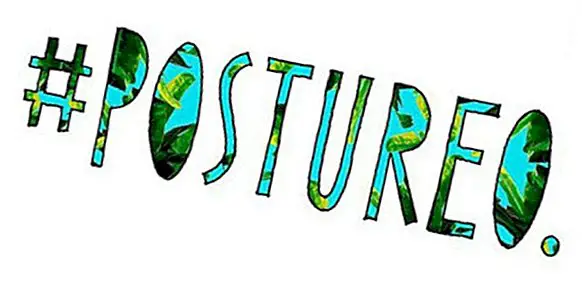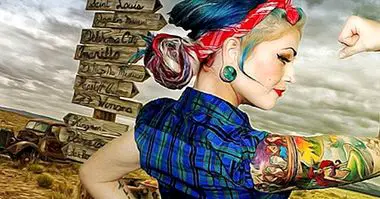Postureo: when the image we project is everything
We all know that, Where there is society, there are people who judge . From haircuts to the aesthetics of tattoos, through the non-verbal language that is used and the products that are consumed, everything that unites us to life in community is crossed by a thousand and one labels designed in the most sophisticated marketing factories .
Yesterday, urban tribes were responsible for keeping these codes of aesthetics and behavior. Today, these pieces of personality to carry have been diluted in a much broader concept: the posture .
Postureo: about posers and ghettos
It is clear that the posture it is not a concept coined by sociologists or psychologists, but rather it is a new word that probably comes from the English "poser", which in turn is a loan from French. This already gives clues as to which context the root of the word posture appeared.
Originally, the word was used to refer pejoratively to those people who pretend to be what they are not . Urban tribes were responsible for extending the use of this word to refer to people who copied their aesthetics without having previously internalized their musical tastes, their values and their customs. Not in academic circles, but in spaces of dissidence. On the street, far from the fixed definitions. A place in which to externalize one's personality is, in part, reinvent yourself .
So, showing off posture meant imitate the aesthetics of a given group without doing the same with their ethics , the content that gives meaning to those haircuts, those sensations transmitted by music and that way of dressing to recognize each other among comrades.
Today all that has been left behind. Now, the posture has become independent from these small ghettos of youth: it has become part of the day to day of most of the urbanitas . It consists of giving the desired image, but not any desired image: concretely, that which allows us to merge with the crowd, not to stand out. Now, this way of pretending is a product for all palates, easily marketable and exportable to all Western countries.
The posture is no longer related to the community, with the specific groups. Today, pretending what you do not know means doing it as an individual who wants to pretend to be something much wider, for all tastes , without shrillness.
New forms of posture: personality to wear
The postureo, as we understand it today, has appeared in the same breeding grounds in which the urban tribes appeared: the externalization of signs related to life beyond work . In the urban tribes, this "beyond work" in which were born the elements prone to be copied to maintain appearances were related to spaces of dissidence: music, concerts, the world of graffiti and skate in public places , etc.
Today, the "beyond work" means, plain and simple, leisure time .
Not all people share the struggles of left-wing punk movements, or bikers who claim for themselves the right to transgress the rules of public space use. Without, however, many more people go to concerts, go on vacation or meet from time to time with friends. And a lot of these people have access to their profiles in the social networks .
Everything is based on social networks
It is in the laboratory of our facebook and twitter accounts where the new posture is given. If before you tried to copy some elements of an easily recognizable local band, today you do the same to pretend to be a normal middle class person, with aesthetic influences well assimilated by the middle class and typical situations of leisure moments . It sums up quite well this theme of the Sevillian rapper ToteKing:
If before the posture was exercised in the street, today is exercised from the solitude of electronic devices , at the moment of selecting photographs and giving the button to upload images. It is something that everyone can do with access to technology, regardless of the social dynamics or the customs of the place.
The selfie stick as a paradigm that something is wrong
An example of this is the rapid popularization of the selfie stick, whose function is make it easier to graphically capture an event: "I was here" . The new posture is such a refined way of pretending that it is not based, as it was a few years ago, on the great artifices. It is based on selective attention. I was here, and for some reason I show you this. I've also been washing the kitchen, but for some reason I'm not showing it to you. I want you to know that I've been there, but not here.And if necessary, I'll buy a stick to take a picture of me when there's no one to accompany me.
On the Internet you can find videos in which people posing posing believing that they are going to take a picture. They are uncomfortable seconds, and it is this discomfort that gives grace to the videos. This feeling of being ridiculous is one of the symptoms of pretending .
In those moments of discomfort, if you pay attention to the faces of the people who pose, you can see the friction between the image you want to give and what you are really doing. It is not an effort to stand out, but to merge with the abstract image of a person who lives life, worth the redundancy.
The totalitarianism of the normal look
The new posture is an artifact born in globalization that is governed by an all-or-nothing mechanism . If two years ago people laughed at the first Chinese tourists who traveled with a selfie stick, today it is perfectly normal to use them. If a few decades ago people pretended to distinguish themselves, today they do so to be more like the members of the global village. Whatever we are, we all have leisure time and we like to live life, they seem to mean.
Increasingly, our social life is based on the avatars that we use in social networks . Increasingly, the image we give is similar to the one we want to give through these virtual profiles. Hopefully, in this eagerness to show what you are, do not eclipse the ways of living life in a spontaneous and original way.



















